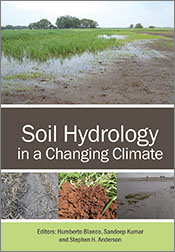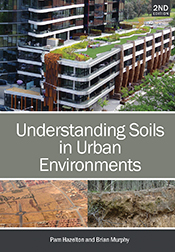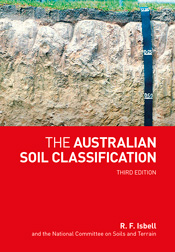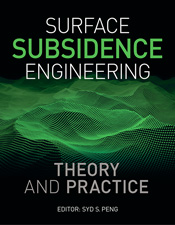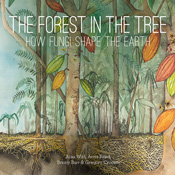Australian Soils and Landscapes
An Illustrated Compendium
By: Neil N McKenzie, David D Jacquier, Ray RF Isbell, Katharine K BrownA unique compendium of the most important and widespread soils of Australia and their associated landscapes.
This essential reference provides an introduction to the remarkable soils and landscapes of Australia. It reveals their great diversity and explains why an understanding of soil properties and landscape processes should guide our use of the land.
Using striking photographs of characteristic landscapes, it begins by describing the basic properties of soils and how Australia's distinctive soils and landscapes have co-evolved. We gain a greater understanding of why particular soils occur at certain locations and how soil variation can influence landscape processes, agricultural productivity and ecosystem function. The book explains the impact of various forms of land use and the changes they can bring about in soil.
+ Full description
This is followed by an invaluable compendium that describes and illustrates over 100 of the more important and widespread soils of Australia, along with their associated landscapes. There is a brief account of each soil's environment, usage and qualities as well as details on chemical and physical properties so we can make more informed decisions about appropriate land-use.
Australian Soils and Landscapes will be a valuable resource for farmers, natural resource managers, soil and environmental scientists, students and anyone with an interest in Australia's unique environment.
- Short descriptionNews
No longer available in a print edition.
Reviews
"This is a book worth waiting for. It reaffirms the importance of understanding the substrate that supports us all. While it builds on the monumental efforts of earlier generations of soil scientist and geomorphologists it breaks free from their long-established pedocentric view of the world. It focuses on those properties and key processes that are important in land resource management. Finally it contains a superb back-up compendium of a selected representative set of Australian soils with photographs, figures and tables. No self-respecting resource and environmental scientist should be without it."
Professor Henry A Nix, AO
". . .an outstanding textbook written for farmers as well as scientists."
Australian Landcare, Dec 2004
"This is a marvelous introduction to the soils and landscapes of Australia!" . . . I regard the present full colour book at about A4-size as a milestone."
Hans van Baren (International Union of Soil Sciences Bulletin 105, November 2004)
"By offering a rich appreciation of the diversity of Australian soils and landscapes, this publication is another step in helping Australians understand the nature of our unique continent and how we need to live with our landscape - the way it is. Here at last is a ready source of information that shows where certain soils occur in the landscape and how we might use them and conserve them for our long-term benefit."
Dr John Williams, former CSIRO Land & Water Chief andMember of the Wentworth Group of Concerned Scientists
"A tour de force as well as a tour d'Australie."
Professor Alex McBratney, University of Sydney
"This excellent book fills an important gap in the literature on the Australian environment. It is is both authoritative and very readable. There is a real need for non-indigenous Australians to improve their understanding of the Australian landscape with its unique character and often great fragility. This book will help us develop our sense of place as inhabitants of this continent."
Dr Peter Lockwood, School of Rural Science and Agriculture, University of New England
"The experience and extensive knowledge of the late Ray Isbell is evident in the selection of the soil profiles, which are grouped by soil order. Each order is introduced with a discussion of defining features, general occurrence, environment and land use, and a map showing the general distribution of the soil group."
Land and Water News, August 2004
“I think a book of this type was long overdue in the Australian soil science community … it is a book that I will use often, for informing myself and others and simply for the well-presented pleasure of a precious natural resource.
Andrew Rate, University of Western Australia (Profile Issue 140, Jan 2005)
“… it is an object lesson to the rest of us in how to convey a large body of technical information to a non-specialist readership. I know of no other book that does it so clearly and compellingly. … Let pedologists and governments in other countries take note.”
R Webster (European Journal of Soil Science v.56 no.2 2005)
“Scientific or technical information is presented effectively and concisely in tables and colour graphics. The cross-sections of soil types are astonishingly beautiful …”
The Australian 4 May 2005
Features
- Provides an introduction to soil properties, processes, and their significance for land use and management.
- Includes a well-illustrated compendium of the most common soils in Australia, showing soil profiles and their associated landscapes and detailing usage and soil properties.
- Explains how Australian soils have evolved, giving a practical context for current day land management.
Contents
AcknowledgementsIntroduction
1 Properties of soil
2 The evolution of Australian soils
3 Characteristic Australian landscapes
4 Soil function within ecosystems
5 Land use, soil change and future management
Compendium of Australian Soils
Rationale and format
Anthroposols - soils formed by humans
Calcarosols - soils dominated by carbonate
Chromosols - neutral to alkaline soils with sharp increases in texture
Dermosols - structured B horizons and minor changes in texture
Ferrosols - high iron levels and minor changes in texture
Hydrosols - wet soils
Kandosols - strongly weathered earths with minor changes in texture
Kurosols - acid soils with sharp increases in texture
Organosols - organic soils
Podosols - soils with accumulations of organic matter, iron, and aluminium
Rudosols - minimally developed soils
Sodosols - alkaline and sodic soils with sharp increases in texture
Tenosols - slightly developed soils
Vertosols - cracking clays
Endnotes
References
Index
Authors
Neil McKenzie is a principal research scientist with CSIRO Land and Water. He has been closely involved with the setting of standards and development of new methods for land resource survey in Australia.David Jacquier specialises in the collection and management of land resource information. He is a project officer with CSIRO Land and Water.
Raymond Isbell (late, CSIRO Land and Water) had a long and distinguished career as a soil scientist specialising in soil description, distribution, genesis and classification. His major achievement was the development of The Australian Soil Classification, first published in 1996.
Katharine Brown, formerly a project officer with CSIRO Land and Water, is a soil scientist and a doctoral candidate at the University of Western Australia.



